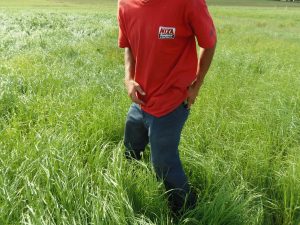Description
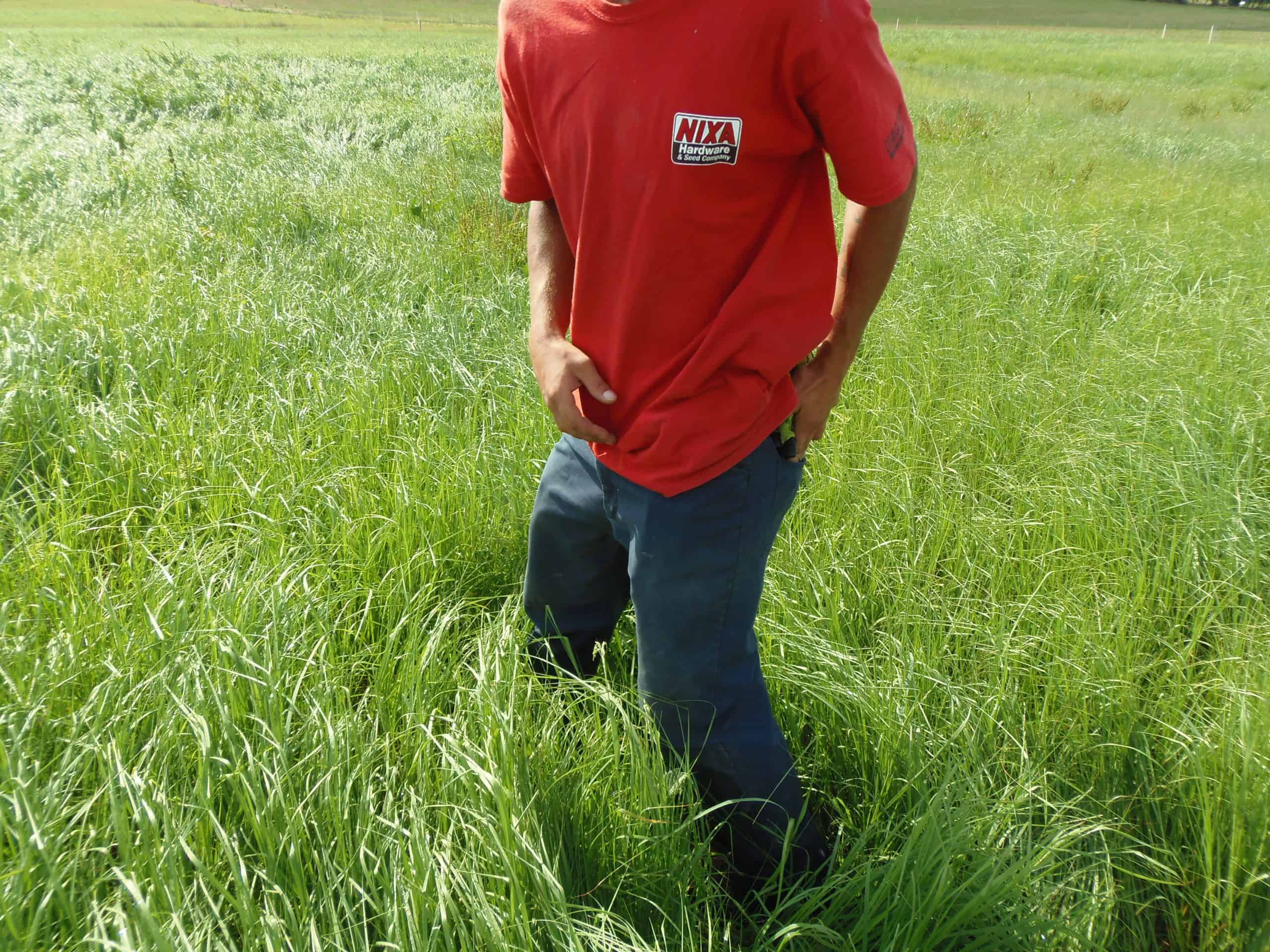
| Type: | Summer Annual | Height: | 24-36 inches |
| Usage: | Summer Pasture
Hay, Silage |
Seeding Rate: | Raw: 8 lbs/ acre
Coated: 16 lbs/acre |
| Plant: | May- June 15 |
The emerging popularity of teff grass in the U.S. has been driven by the crop’s wide range of geographic adaptation, the ability to produce competitive yields wit
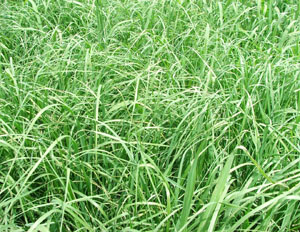
h low inputs and superior forage quality versus other summer annual species. Here’s a powerful set of reasons to plant teff whenever there’s a need for lots of quality forage fast!
Wide Adaptation
Teff grass fits forage needs from Southern New England down into Central Florida, all across the Midwest, Southeastern and Plains states, Intermountain West and the Southwest desert regions. Teff has performed well on moisture-short to waterlogged soils and thrives when irrigated.
Summer Production
Teff grass seed is planted in late spring after danger of frost has passed with multiple harvests during the hot summer months. The forage can be used as feed to bridge the normal summer slump of pastures or as stored forage for the coming winter feeding season.
Fast Growth
Teff grass seed germinates quickly and is usually ready for first harvest at the early boot stage 45-55 days after planting. Subsequent cuttings are usually ready for harvest in 28-35 days, depending upon growing conditions and region grown.
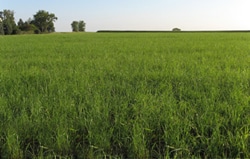
High Yield Plus High Quality
Single harvest hay yields are often in the 1.5 to 2.5 tons per acre with quality comparable to other forages such as timothy. In multiple public and private trials, summer yields have ranged from 4 to 7 tons per acre of dry hay when planting improved forage type teff varieties.
Harvest Method
Teff grass can be harvested as dry hay, silage or grazed. However, the prevalent harvest method is dry, baled hay.
Livestock Palatability
Teff forage is fine stemmed, leafy and “soft” which is very palatable to livestock.
No Anti-quality Compounds
Teff forage does not have anti-quality compounds such as nitrates or prussic acid that are associated with other summer annual species.
Temperature Requirements
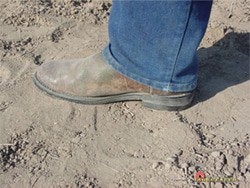
Hold off planting teff until soil temperatures are in the 65 degree Fahrenheit range. This means teff should be planted after most other forages and row crops. Planting earlier may slow stand establishment and give weeds an unnecessary head start. Teff is a C-4 grass like corn and sorghums and will produce best during periods of maximum heat unit accumulation. Growth will slow as days become shorter in the fall and will cease upon the first killing frost.
Soil Types
Teff seed has performed well on soil types ranging from low-desert sands to waterlogged clays. The species appears to tolerate a wide range of soil pH from acid to alkaline and reacts to salinity much like alfalfa but better than most sorghum types.
Seed Bed Preparation
Planting into a firm seed bed is essential for stand establishment. Teff seed is small and must be placed near the soil surface with good seed soil contact for quick, vigorous germination. Prepare a bed that your heel barely marks or “you can bounce a basketball on” as some agronomists advise. When complete tillage isn’t possible, remove the trash, seed shallow, cover and firmly pack.
Teff is considered a low input crop, requiring minimal fertilization. Plantings following alfalfa or sod may not require additional nitrogen for the first harvest. However, teff following a small grain may need nitrogen applied for the first harvest. Generally, total seasonal supplemental nitrogen needs will be in the 50-90 pound range depending upon yield, the number of crops and nitrogen source. Don’t over apply nitrogen as fertilizer or as manure.
Planting Rates and Planters
The recommended seeding rate is usually 8 pounds per acre for raw seed and 16 pounds per acre for coated seed. Seeding rates above these ranges may lead to lodging, stand loss and reduced yield.
Stands can be established with broadcast spinners, the Brillion seeder and thru the small seed box of most grain drills provided the seed bed has been properly firmed beforehand. After planting, it is a good practice to roll or cultipack the field to insure good soil seed contact. Avoid dragging after planting, which tends to bury seed too deep for uniform germination.
Teff can be aerial applied, but the seeding rate of coated seed should be 16 pounds per acre.
Seeding Date
Teff can be planted in the spring after the risk of frost has passed. For quick emergence, the soil temperature should be at least 65 degrees Farenheit and warming. When double cropping teff after forages or small grains, the critical concern is soil moisture rather than soil temperature.
Seeding Depth
For best results, place seed no deeper than 1/8 to 1/4 inch deep and pack for good soil seed contact. Planting at this shallow depth, will leave seed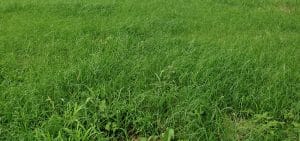 uncovered on the surface but limit seed placed deeper than desired. Usually seed placed deeper than ½ inch won’t emerge. Seed placed at the recommended depth in a firm, moist seed bed usually emerges in 4 or 5 days.
uncovered on the surface but limit seed placed deeper than desired. Usually seed placed deeper than ½ inch won’t emerge. Seed placed at the recommended depth in a firm, moist seed bed usually emerges in 4 or 5 days.
Weed Control
Seed bed preparation, soil temperature and seeding depth are the key cultural practices for weed control in teff. There are few labeled herbicides so the primary weed control on the majority of U.S. acres is accomplished by the following cultural practices:
- Controlling weeds in the previous crop or pasture
- Pre-till to incorporate field residue and to get a “first flush” weed growth
- Planting after reaching a 65 degree soil temperature encourages quick emergence
- Later planting dates and stand density can help reduce weed competition
- Usually, if teff emerges quickly and has a two week window of favorable weather to establish a root system, the crop can outcompete most weeds
- Most broadleaf weeds can be removed with the first harvest 45-55 days after planting
Dairy Rations
Producers who plan to feed their teff to lactating cows should pay special attention to harvest maturity. Like other grasses and legumes, teff’s forage quality decreases with maturity. Harvest just before heading to maximize Relative Feed Quality (RFQ) and milk per ton. High quality teff hay normally has a range from 100 to 125 RFQ. Animals prefer teff to other forages so teff is best fed in a Total Mixed Ration (TMR) to deter bunk-sorting. Most nutritionists will find teff easy to fit into the ration with the results of a good feed test and an adequate forage inventory.
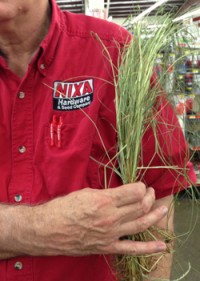
This teff field was harvested twice as hay and the third crop is being grazed after frost. No prussic acid or other known livestock health or safety concerns.
Teff can be fed as dry hay to over-wintering beef cows or rotationally grazed by lactating cows during the summer slump period. For cattle on feed, follow the dairy suggestions above.
Teff is considered a premium hay for a wide range of livestock including dairy, beef, sheep and horses. The “soft forage” is very palatable and readily consumed as dry hay, silage or pasture by livestock. The forage quality is very similar to timothy hay at the various maturity stages as shown in the table below.
| Forage Quality of Timothy and Teff Grass Hay Compared | ||
| Quality Parameters | Timothy Hay | Teff Hay |
| % Crude Protein (CP) | 8-14 | 9-14 |
| Acid Detergent Fiber (ADF) | 32-36 | 32-38 |
| Neutral Detergent Fiber (NDF) | 53-59 | 53-65 |
| Total Digestible Nutrients (TDN) | 57-65 | 55-64 |
